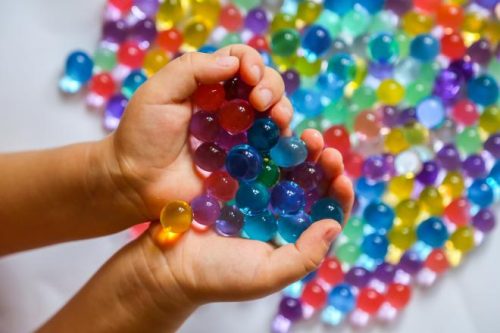
A fresh health advisory has been issued regarding the hazards associated with water bead toys.
After years of injury reports and safety advisories, water beads continue to be a serious and growing health hazard for young children, the Consumer Product Safety Commission said on Tuesday.
The absorbent polymer beads are often marketed as colorful, slimy, sensory items for kids to play with. They can be as small as a stud earring — little enough to swallow — but grow to the size of a marble or even a golf ball when immersed in water. Once inside a child’s body, they can cause gastrointestinal blockages.
The CPSC recorded nearly 7,000 water bead-related ingestion injuries in emergency rooms between 2018 and 2022.
The agency issued warnings this week about two products with toxicity risk, urging consumers to throw away water beads from the brands Jangostor and Tuladuo, which were sold on Amazon as recently as November 2023. According to the CPSC, the products contain unsafe levels of acrylamide, a chemical compound considered a probable human carcinogen. High levels of exposure can also have negative effects on the nervous and reproductive systems.
“The product warnings highlight that water bead hazards can go beyond ingestion, expansion and obstruction inside a child. Acrylamide is a known carcinogen,” the CPSC said in a release. “The large water beads in CPSC’s warnings contain levels of acrylamide in violation of the Federal Hazardous Substances Act.”
Jangostor and Tuladuo, both located in China, have not “agreed to an acceptable recall,” the CPSC said.
The agency has been issuing recalls and warnings about water beads for more than a decade, and some parents, nonprofits and lawmakers have pushed to ban the beads altogether.
Amazon, Walmart and Target said in December that they would stop selling water beads.
Ashley Haugen, a mother of two from San Antonio, bought her older daughter water beads for her 6th birthday in 2017. A week later, her younger daughter Kipley, then just 1 year old, developed a rash around her mouth, became fussy and wasn’t sleeping well. More than two months later, Kipley began vomiting violently, Haugen said.
Emergency room doctors noticed a round mass in Kipley’s small intestine and performed an emergency surgery to remove what turned out to be pieces of water beads.
But problems persisted, Haugen said: In the following weeks, Kipley became clumsier and stopped talking or using her baby sign language.
Kipley’s developmental pediatrician “diagnosed her with toxic brain encephalopathy due to chemical exposure,” Haugen said. “It is a brain injury due to chemical exposure, so for her, it has changed the trajectory of her life.”
The beads Kipley ingested contained acrylamide.
About five years later, Haugen created “That Water Bead Lady,” a nonprofit group that raises awareness about the dangers of water beads, supports families whose children get injured by them and lobbies to ban water bead sales.
The Ban Water Beads Act, which would prohibit sales of most water bead toys, was introduced by Rep. Frank Pallone Jr., D-N.J., in November, due in part to Haugen’s advocacy work.
One maker, Buffalo Games, also recalled more than 50,000 of its water bead activity kits in September after a 10-month-old in Wisconsin died after swallowing the beads.
The CPSC announcement emphasized that if water beads grow inside the body, they can cause “severe discomfort, vomiting, dehydration, intestinal blockages, or life-threatening injuries that can require surgery.”
“They’re easy to swallow, but then if they continue to expand when they’re in the child’s gastrointestinal system, then we get in trouble where it can expand so much that it can cause some blockage,” said Dr. Elizabeth Murray, a pediatric emergency medicine physician at the University of Rochester and a spokesperson for the American Academy of Pediatrics.
Murray added that she frequently sees children visit the emergency room with water beads lodged in their noses or ears, which can cause pain, blockage or infection.
“I would say a couple times a month there’s a concern for a water bead being somewhere it shouldn’t be,” she said.
For parents wondering how to keep children safe, the website Healthychildren.org (which is backed by the American Academy of Pediatrics) offers recommendations. It suggests waiting until all children in a household are at least 3 before purchasing water beads and supervising them while playing with the toy. Parents should store water beads in a tightly sealed container that young children can’t reach and permit kids to use the beads only on a table over a hard floor, then sweep or vacuum after.
Murray also suggested playing with only a small amount of beads at a time, or placing a rimmed baking sheet under the beads on a table to lessen the likelihood that they’ll roll onto the floor for a small child to find.
Haugen, however, said that in her view, even following all of those recommendations will not sufficiently protect children.
“Water beads look like candy. They are tiny, they scatter, bounce, roll, and can hide in your home for years,” she said, adding: “Water beads are not toys, and should not be used for play, period.”
